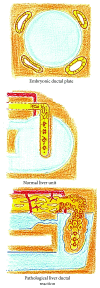Mesenchymal Stem Cells for Liver Regeneration in Liver Failure: From Experimental Models to Clinical Trials
- PMID: 31191671
- PMCID: PMC6525815
- DOI: 10.1155/2019/3945672
Mesenchymal Stem Cells for Liver Regeneration in Liver Failure: From Experimental Models to Clinical Trials
Abstract
The liver centralizes the systemic metabolism and thus controls and modulates the functions of the central and peripheral nervous systems, the immune system, and the endocrine system. In addition, the liver intervenes between the splanchnic and systemic venous circulation, determining an abdominal portal circulatory system. The liver displays a powerful regenerative potential that rebuilds the parenchyma after an injury. This regenerative mission is mainly carried out by resident liver cells. However, in many cases this regenerative capacity is insufficient and organ failure occurs. In normal livers, if the size of the liver is at least 30% of the original volume, hepatectomy can be performed safely. In cirrhotic livers, the threshold is 50% based on current practice and available data. Typically, portal vein embolization of the part of the liver that is going to be resected is employed to allow liver regeneration in two-stage liver resection after portal vein occlusion (PVO). However, hepatic resection often cannot be performed due to advanced disease progression or because it is not indicated in patients with cirrhosis. In such cases, liver transplantation is the only treatment possibility, and the need for transplantation is the common outcome of progressive liver disease. It is the only effective treatment and has high survival rates of 83% after the first year. However, donated organs are becoming less available, and mortality and the waiting lists have increased, leading to the initiation of living donor liver transplantations. This type of transplant has overall complications of 38%. In order to improve the treatment of hepatic injury, much research has been devoted to stem cells, in particular mesenchymal stem cells (MSCs), to promote liver regeneration. In this review, we will focus on the advances made using MSCs in animal models, human patients, ongoing clinical trials, and new strategies using 3D organoids.
Figures



References
-
- Sherlock S. Diseases of the Liver and Biliary System. Wiley; 2007. The portal venous system and portal hypertension; pp. 147–186. - DOI
Publication types
LinkOut - more resources
Full Text Sources

